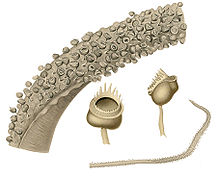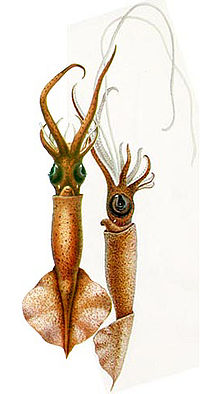- Whip-lash squid
-
Whip-lash squid 
Mastigoteuthis flammea Scientific classification Kingdom: Animalia Phylum: Mollusca Class: Cephalopoda Subclass: Coleoidea Order: Teuthida Suborder: Oegopsina Family: Mastigoteuthidae
Verrill, 1881Genera The Mastigoteuthidae, also known as whip-lash squid, are a family of small deep-sea squid. Approximately 20 known species in two genera are represented, with members found in both the mesopelagic and bathypelagic zone of most oceans. Originally described by Verill in 1881, it was later lowered by Chun (1920) to a subfamily (Mastigoteuthinae) of the Chiroteuthidae, which are also called whip-lash squid on occasion. However, Roper et al. (1969) raised it back to the family level, and this has not been changed since.
Contents
Description
Mastigoteuthids range in size from quite small species in the genus Mastigoteuthis, to relatively gigantic sizes in the genus Idioteuthis. However most are rather small, from 3–15 centimetres total mantle length. Their most distinctive features are their extremely elongate tentacles—which retract into membranous lateral sheaths of the fourth (and largest) arms—and their very large ovate fins, which may occupy up to 80% of the mantle length in some species. It is from these 'whip-like' tentacles that their common name derives. Unlike most other squid, the club of the mastigoteuthid tentacle is not significantly (usually not at all) broader than the rest of the tentacle and is covered in very small suckers—in some species, invisible to the naked eye—which impart an extremely sticky property to the clubs, themselves answering for 70% or more of the tentacle's length in some species.
Many species also possess photophores (bioluminescent organs) which may be located on either the body, the tentacular clubs, the surface of the eye, or the eyelid. These photophores have a "lens" of chromatophores, pigment cells which may allow the squid to modify the colour of the light produced by the photophores. The mantle of some species is adorned with conical or hemispherical tubercles. Most species have arm suckers that possess sharp or blunt conical teeth, which are either larger or present only on the distal side, however some species, such as Mastigoteuthis inermis, have smooth sucker rings with no teeth at all. Coloration is typically a rich reddish brown.
Two species (Idioteuthis tyroi and I. cordiformis) are known to have greatly expanded tentacular clubs as paralarvae and subadults.
Behaviour
Members of this family have scarcely been observed in life, but at least two species (Idioteuthis hjorti and Mastigoteuthis magna) are known to hover above the ocean bottom in a vertical orientation, the head pointing downward. The squid use their large fins to maintain this orientation and use both their extended tentacles as a pair of snares, held rigidly at a constant distance apart: this has been termed the "tuning fork" position. Prey items apparently consist primarily of benthic crustaceans.
Although mastigoteuthids possess ink sacs (which would suggest forays into shallower, lit waters), all observations have been over the bottom in deep water. The squid seem to lack the ability of rapid jet propulsion and instead rely on their capable fins.
Species
This family is taxonomically misunderstood. With many species represented by single, damaged, and juvenile specimens, this group is still creating controversy in the taxonomic community. Salcedo-Vargas and Okutani (1994) reclassified the family and eliminated the genus Echinoteuthis, added two subgenera, and reduced the number of species to eight. Three years later, after the careful examination of skin tubercles and photophores, Salcedo-Vargas eliminated his subgenera, and increased the number of species to 17 (Salcedo-Vargas, 1997).
- Genus Idioteuthis
- Genus Mastigoteuthis
- Mastigoteuthis agassizii
- Mastigoteuthis atlantica
- Mastigoteuthis dentata
- ? Mastigoteuthis flammea
- Mastigoteuthis glaukopsis
- Mastigoteuthis grimaldii
- Mastigoteuthis inermis
- Mastigoteuthis iselini
- Mastigoteuthis magna
- Mastigoteuthis microlucens[1]
- Mastigoteuthis psychrophila
- Mastigoteuthis pyrodes
- ? Mastigoteuthis schmidti
The question mark (?) indicates questionable placement within the genus. The specific arrangement of the species under Idioteuthis indicates 4 different subgroups under revision. I. famelica is now verified to be member of genus Mastigoteuthis.[citation needed]
References
- ^ Young, R. E.; Lindgren, A.; Vecchione, M. (2008). "Mastigoteuthis microlucens, a new species of the squid family Mastigoteuthidae (Mollusca: Cephalopoda)". Proceedings of the Biological Society of Washington 121 (2): 276–282. doi:10.2988/07-40.1.
External links
Categories:- Squid
- Bioluminescent organisms
Wikimedia Foundation. 2010.


